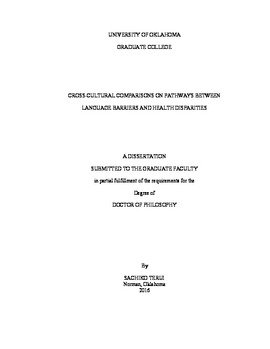| dc.description.abstract | Despite a large number of studies verifying the correlations among language barriers in healthcare settings and health disparities, the precise ways language barriers contribute to health disparities is less clear. This dissertation is an examination of the precise pathways and processes among language barriers and health disparities, the challenges and meanings of language barriers in across sociopolitical and sociocultural environments (Japan and the US), and how these differences influence the quality of health care. Japan is often characterized, in Hofstede’s (1980) terms, as a high-power distance, collectivistic culture, and a relatively homogeneous environment. The US, on the other hand, is described as a low-power distance (Hofstede, 1980), individualistic culture, and is well known as a country of immigrants. These two countries provide significantly different social environments, particularly useful for examining the functions and meanings of language barriers. Data presented in this study were collected through in-depth interviews with language-discordant immigrants and minorities living in Japan (N=30) and the US (N=30). Participants recruited in Japan are from 13 counties, and the participants recruited in the US are from 10 countries.
The current study employed the narrative approach (Fisher, 1987) along with constructivist grounded theory (Charmaz, 2006). Using the semi-structured interview guides, the author explored the ways these participants understand their experiences of facing language barriers in healthcare settings. Comparative analysis revealed the ways language barriers create challenges in accessing healthcare and related processes. In accessing healthcare, data show that language barriers create challenges in utilizing healthcare, especially in emergency situations and in managing identities and interpersonal relationships in host countries. In the process of healthcare, language barriers create challenges in asserting desirable identities, exchanging information, and building relationships with healthcare providers. The findings highlight the multidimensional nature of language barriers in healthcare settings. Based on these findings, the author presents a diagram of pathways and processes among language barriers and health disparities. Also, a broader definition of language barriers in healthcare settings is proposed. | en_US |

